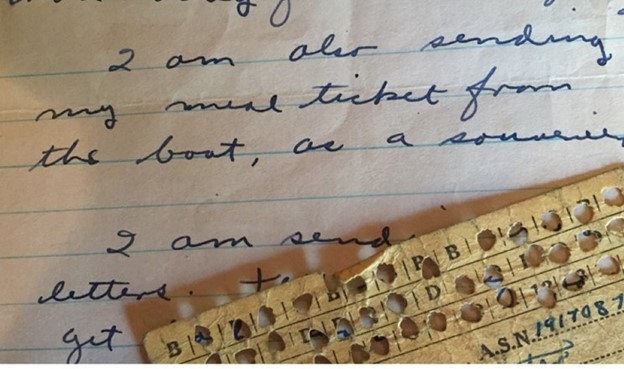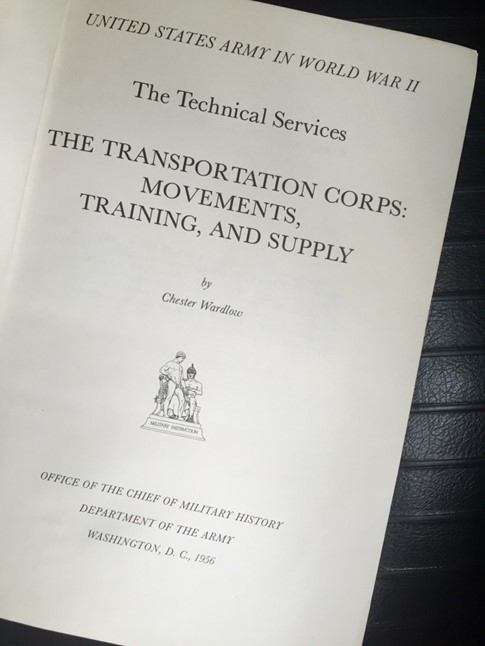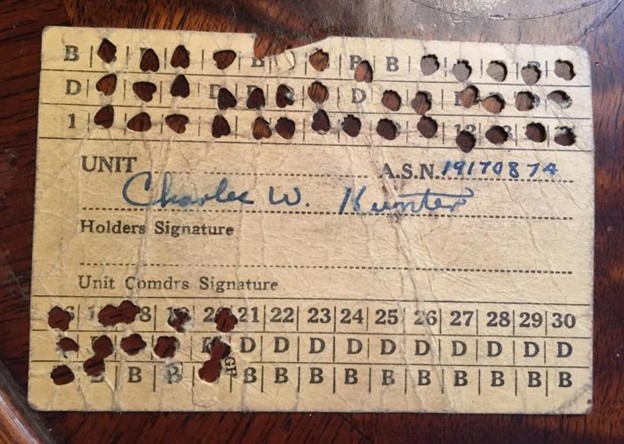EDITOR’S NOTE: These are the final blogs about Charles Hunter. We thought it fitting to wrap up this series Veterans Day weekend. We have been sharing entries from Old Tillamook Times, provided by Sandi Burgess Botten Dean, featuring Karen Kranweiss Nudelman’s blog in which she describes the search and book writing that started a little over 10 years ago when she first received “the letters” and began reading. Then came the idea for a story, then a book – “Dear Folks” tells a young man’s story through letters he wrote home to his parents in Tillamook, Oregon. Watch for more information about the book. Links to the introduction to the story and the series are below.
by Karen Krantweiss Nudelman
One tiny, worn and ripped yellow piece of paper can hold a boatload of answers.
On November 23, 1944, Chuck was in New Guinea, spending his first Thanksgiving away from his family. His first letter home to his parents consisted of censor-approved information (oops, almost) about his long journey overseas. Before sealing the envelope, he tucked in the yellow meal card he carried on the ship. The hole-punches marked the daily meals he had consumed. With it came a simple explanation.

The card survived the inspection of the censor, the 6,500-mile trip back to Oregon and has held together – just barely – for the last 70 years.
When it first slipped out between the pages of Chuck’s letter, I barely gave it notice. However, over the last few months, its presence in the archive has proven to be very valuable.
At the end of Chuck’s furlough in the fall of 1944, Chuck left his hometown of Tillamook, Oregon and travelled to San Francisco. On the docks of the Presidio, he was met by hundreds of fellow passengers from the Army, Navy and Coast Guard. But our information stops abruptly there. Without the name of the troopship, Kim and I had no idea what day Chuck boarded the vessel or how long it took them to reach New Guinea.
Every week, Kim and I meet to write together. We always have the Chuck’s letters on hand for inspiration. A few months ago, Kim was flipping through the binder of letters, when this tiny yellow card caught her eye. Kim took a longer glance at the meal card and abruptly announced “Three holes per day. All we need to do is count the columns.”
It’s amazing how you can stare at something and never really see it. She was right. There were 19 columns of punched holes. He was on the ship for 19 days. The answer was always in plain sight.
We were giddy for a few minutes, excited about the discovery, when it occurred to me that Chuck may have had another motive to sharing the meal card with his parents.
“Kim, is it possible Chuck sent this home to pass on information? Was this his way of telling his parents how long his trip took?” While there’s no way to confirm that theory, it would not be at all surprising. Chuck and his parents were exceptionally perceptive.
About a week later, I shared this story with another friend of mine named Afy. “We know he traveled in November for 19 days, but we are still in the dark about the date his ship left San Francisco. I typically carry photos of the archive on my phone, in case I need to access it remotely. She glanced at my phone and immediately pointed to the punched holes and said, “There are thirty days in November. His meals started on November 2.”
Yep. It was clear that the first column was not touched. B for Breakfast, D for dinner and the number 1 – for the date, November 1, 1944. Never felt the sweet bite of a hole puncher. The dates of his journey were revealed as November 2-20, 1944. Each person who looked at this card identified something new to glean from it.
 I found this book on one of my online treasure hunts, to aid with the research. It doesn’t hold any big revelations, but it did have a few minor ones.
I found this book on one of my online treasure hunts, to aid with the research. It doesn’t hold any big revelations, but it did have a few minor ones.
Including, what happened to lunch? Didn’t these men deserve a midday nosh?
Not according to the Army. The men were only allotted two meals a day. The powers that be decided that they would get by perfectly fine on less calories since their physical activities were limited.
And just when I thought the meal card had no more secrets left to spill…my friend Susan found another.
Susan, a very good friend who just happens to work for the National Archives, has played a key role in connecting us with historians at various Presidential Libraries. Susan is enamored with Chuck, and we often get together to talk about the book’s progress. Recently, we were sitting at my dining room table looking over the archive. I pulled out the meal card with my naked hand and she cried out, “Oh my goodness, that’s an original signature. Where are your gloves?”
I did not own gloves, a tweezer or a mini scalpel. I am not an archivist, and
I don’t play one on TV. But she was absolutely right. It was his full signature and the only one we have. Maybe I should invest in some gloves.
“Karen, didn’t you say he wrote his parents about being seasick for a few days at the beginning of the trip? Look right here. He skipped dinner and breakfast back-to-back. I bet that’s when he felt ill.”
It was an intriguing thought, so I went back to the letter he wrote while on board. It appears that Chuck mentioned the first day and a half of the journey being rough, but nothing specifically about November 9-10, 1944.

Susan’s idea about skipping meals was a great one, but not necessarily the cause of the lost meals. Perhaps he wasn’t sick at all on those days but serving a four-hour guard duty looking out for enemy submarines. Or maybe he didn’t want to interrupt a hot streak playing cards. All of this speculation reminded me of a very important rule in research. Don’t try to prove a theory by providing the data to back it. Instead, follow the trail of clues and go where it takes you. With that said, it’s still enormously fun to speculate.
One unknown piece of the puzzle still eluded me. The name of his troopship. Every path I followed led to a brick wall. I knew the dates he traveled, the port he departed and his arrival destination. I was hopeful that the equation components would reveal the name of his vessel. I finally learned why that was never going to happen.
A historian at the National Archives wrote a reply to my letter of inquiry. It was not good news. In 1951, the Department of the Army destroyed all manifests, logs of vessels, and troop movement files of United States Army transports for World War II and most of the passenger lists.
I can’t deny that I’m disappointed. It’s very hard to push myself away from the table when I’m still hungry for more. However, this book isn’t going to write itself. Time to close this chapter. For now.
Here are links to the previous stories about Karen’s journey to document Chuck Hunter’s life:
OLD TILLAMOOK TIMES: “Dear Folks” – Series #8 – One typewriter, slightly damaged …
OLD TILLAMOOK TIMES: “Dear Folks” – Series #9 – September 22, 1945
OLD TILLAMOOK TIMES: “Dear Folks” – Series #10 – The truth, declassified
OLD TILLAMOOK TIMES: “Dear Folks” Series #11 – And we who pay him homage …


